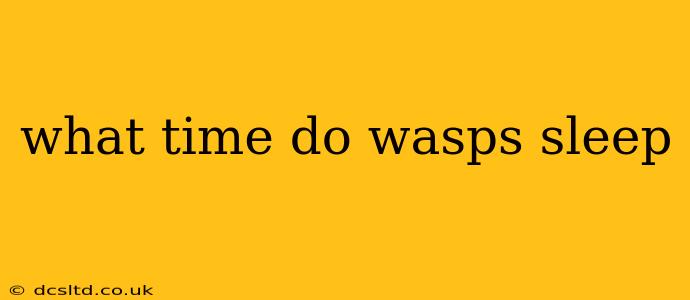Wasps, those buzzing insects often associated with summer picnics and stinging surprises, have a fascinating life cycle. But unlike many creatures, their sleep patterns aren't as straightforward as simply "going to bed" at a certain time. This article delves into the intriguing question: what time do wasps sleep? We'll explore their rest habits, activity cycles, and the nuances that make understanding their "sleep" more complex than you might think.
Do Wasps Sleep Like Humans?
No, wasps don't sleep in the same way humans do. They don't have the same kind of deep, restorative sleep characterized by REM cycles. Instead, they exhibit a state of inactivity and reduced responsiveness, often referred to as "resting" or "quiescence." This resting period is crucial for their survival and allows them to conserve energy and recover.
When Are Wasps Most Inactive?
Wasp activity is heavily influenced by environmental factors, primarily temperature and light. Generally, wasps are most inactive during the cooler night hours and during periods of inclement weather. While they don't completely shut down, their movements are significantly slower, and their responsiveness to stimuli is greatly reduced. You'll find them less active in the early morning and late evening hours.
What is the difference between a wasp resting and being dormant?
Wasps rest throughout the day, taking breaks to conserve energy between foraging trips or other activities. Dormancy, however, is a completely different state. It refers to a period of inactivity, often during winter months, where the wasp's metabolism significantly slows down, allowing them to survive periods of low food availability and harsh weather. This is usually experienced by the queen and sometimes other adult wasps, depending on the species.
How do wasps rest at night?
During nighttime hours, wasps typically seek shelter to protect themselves from the elements and predators. This could be within their nests, under leaves, or in crevices. Their rest isn't a continuous deep sleep; rather, it's a state of low activity punctuated by brief periods of wakefulness. This allows them to respond to potential threats or changes in their environment.
Do all types of wasps have the same sleep patterns?
The sleep or resting patterns of wasps can vary slightly depending on the species, their social structure (solitary or social), and the ambient temperature. However, the general principle of reduced activity during cooler hours and periods of inclement weather remains consistent across most wasp species.
Do wasps hibernate?
This depends on the wasp species. Some wasp species will hibernate in the winter. This is usually the queen that hibernates, which then begins the colony again in the spring. Many other wasps will die off during the colder months.
Conclusion: Understanding Wasp Rest
While wasps don't sleep like humans, they do enter periods of inactivity and reduced responsiveness crucial for their survival. These periods are most pronounced during cooler night hours and inclement weather. Understanding these patterns helps us appreciate the fascinating complexities of wasp behavior and their adaptation to their environment. Remember, respectful observation is key when encountering wasps in their natural habitat. Avoiding disturbances during their rest periods helps maintain their well-being and the balance of the ecosystem.
